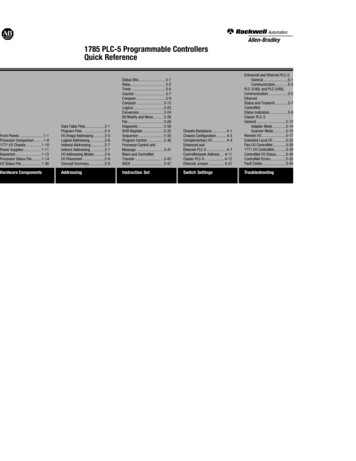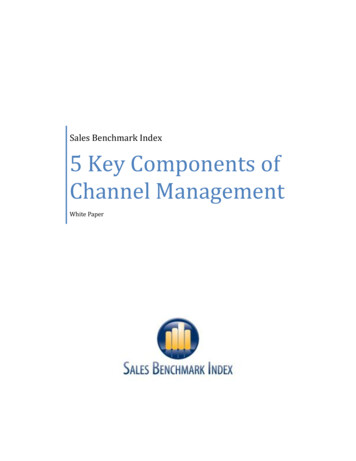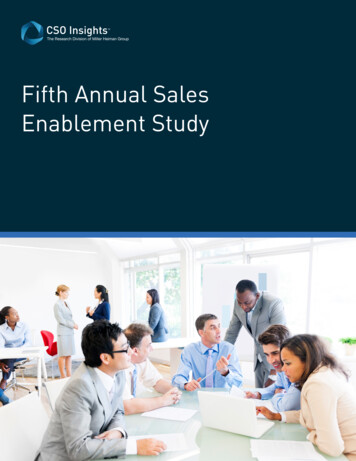
Transcription
CSO Insights 2016 Channel Sales Optimization Study 2016 Miller Heiman Group All Rights Reserved.
CSO Insights 2016 Channel Sales Optimization StudyTerms and ConditionsPrinted in the United States of America. Except as permitted under the United States CopyrightAct of 1976, no part of this publication may be produced or distributed in any form or by anymeans, or stored in a database or retrieval systems, without the prior written permission of thepublisher. For additional information, contact Miller Heiman Group, Inc. 10901 W. Toller Drive,Suite 202, Littleton, CO 80127, email: barry.trailer@csoinsights.com.The reader understands that the information and data used in preparation of this report were asaccurate as reasonably possible at the time of preparation by the publisher. The publisherassumes no responsibility to update the information or publication. The publisher assumes thatthe readers will use the information contained in this publication for the purpose of informingthemselves on the matters which form the subject of this publication. This publication is licensedwith the understanding that neither the authors nor those individuals interviewed are engaged inrendering legal, accounting, or other professional advice or services. If legal or other expert adviceis required, the services of a competent professional person should be sought. The publisherassumes no responsibility for any use to which the purchaser puts this information.All views expressed in this report are those of the individuals interviewed and do not necessarilyreflect those of the companies or organizations that may be affiliated with Miller Heiman Group.All trademarks are trademarks of their respective companies. 2016 Miller Heiman Group All Rights Reserved.
CSO Insights 2016 Channel Sales Optimization StudyAcknowledgmentsI would like to thank all the sales leaders and channel sales professionals who took time out oftheir busy schedules to share the data, insights, and best practices they use to optimize sellingthrough a channel. Without their support, the development of the research knowledge base usedto create the 2016 Channel Sales Optimization study would not be possible.Next, I would like to thank Accenture for their partnership and thought leadership support forthis project. Accenture has been a trusted advisor and client of CSO Insights for over 15 years.Lastly, I would like to thank our editing team whose hard work and diligence made this projectpossible. Thanks to Paul Maxwell, Diane Hodges, Melissa Paulik, and Andy Jesmok.Sincerely,Kim CameronDirector, Studies and ServicesCSO Insights 1 (775) 831-9013kim.cameron@csoinsights.com 2016 Miller Heiman Group All Rights Reserved.
CSO Insights 2016 Channel Sales Optimization StudyTable of Contents2016 CHANNEL SALES OPTIMIZATION STUDY INTRODUCTION.1PROCESS FOR SUPPORTING AND ENGAGING CHANNEL PARTNERS.5LEVELS OF RELATIONSHIPS WITH CHANNEL PARTNERS – HOW PARTNERS VIEWYOUR COMPANY .7SALES ENABLEMENT SERVICES OFFERED TO CHANNEL PARTNERS .9CHANNEL PARTNERS’ RATING OF YOUR COMPANY’S PRODUCT TRAINING . 11YOUR COMPANY’S VISIBILITY INTO YOUR CHANNEL PARTNERS’ PIPELINES . 13CHANNEL SALES’ CORE FUNDAMENTALS . 16ABILITY TO ARTICULATE BUSINESS DRIVERS TO AFFECT CHANNEL’S MINDSHARE . 19CHANNELS’ INFLUENCING SKILLS . 22CHANNEL CAN CREATE AN OVERALL STRATEGY FOR DEVELOPMENT OF APARTNERSHIP. 24LEADING AND MANAGING PARTNERSHIPS . 26ABOUT CSO INSIGHTS. 28 2016 Miller Heiman Group All Rights Reserved.
CSO Insights 2016 Channel Sales Optimization Study2016 CHANNEL SALES OPTIMIZATION STUDY INTRODUCTIONThe data used for this analysis was gathered as part of CSO Insights’ biannual Channel SalesOptimization study. As part of this research effort, we used the first 110 respondents surveyedfrom companies worldwide, collecting information on 58 channel management effectivenessrelated metrics. We continue to leave the survey open to collect additional data for benchmarksbased on geography, vertical industry, company size, etc.By way of an overview of the study demographics, 39% of the study participants worked withUnited States-based companies and 61% were with international firms. Nearly all the studyparticipants worked for companies that focus on B2B sales. Regarding company size, 35% of therespondents work for firms with revenues greater than 1B, 24% for companies with 50M - 1Bin revenues, and 41% for firms with less than 50M in revenues.Next, we’d like to share an overview of key metrics. The following pie chart shows a breakdownof the percentage of a company’s total revenues generated by channel partners. We see a mix offirms heavily dependent on channel partners for their overall success compared to firms that havea minor channel presence.One of the first areas we wanted to explore was how revenue generation is spread across thepopulation of channel partners. The following chart shows a breakdown of the answers wereceived when we asked, “How much of channel revenues are generated by the top 20% of allpartner firms?” 36% of the respondents reported their top-tier partners are generating greaterthan 70% of all channel revenues.1 2016 Miller Heiman Group, Inc. All Rights Reserved.
CSO Insights 2016 Channel Sales Optimization StudyWe also wanted to gauge the success of channel partners in terms of meeting their revenueobjectives. A breakdown of the response is shown the following chart, where results vary widely.Next, in terms of the importance and growth of a channel in the overall sales mix, we asked studyparticipants to tell us what changes they anticipated in the size of their channel network over thenext twelve months. The chart below shows that the vast majority of professionals surveyed viewthe channel as important and will continue to grow their channel network.2 2016 Miller Heiman Group, Inc. All Rights Reserved.
CSO Insights 2016 Channel Sales Optimization StudyThe big question is, what needs to be done to maximize the performance of the channel? In thefollowing 2016 Channel Sales Optimization Key Trends Analysis, we will focus on the current stateof channel management performance. We will highlight the challenges facing channel salesprofessionals, drill into why those problems exist, and then provide insights into how to keepmoving the performance bar even higher for this year and beyond. We have also produced aPowerPoint presentation with a summary of charts that show the responses to questions askedin the 2016 Channel Sales Optimization study.As always, we hope the information presented in this analysis will help you effectively optimizeyour organization’s channel management efforts. While we believe the issues raised have broadapplicability, we encourage you to use this information only as the basis for brainstorming andgoal-planning sessions for identifying and prioritizing your channel management objectives.Everyone can benefit from understanding the strategies and tactics other companies are using,but in the end, you must implement solutions that fit your specific business needs and not thoseof other firms.3 2016 Miller Heiman Group, Inc. All Rights Reserved.
CSO Insights 2016 Channel Sales Optimization StudyTo discuss this report in detail, or if you have any questions or comments on the informationpresented in this report, feel free to contact either of us.Sell well,Barry TrailerChief Research OfficerCSO Insights 1 (916) 712-9621barry.trailer@csoinsights.com4Jim DickieStrategic AdvisorCSO Insights 1 (303) 521-4410jim.dickie@csoinsights.com 2016 Miller Heiman Group, Inc. All Rights Reserved.
CSO Insights 2016 Channel Sales Optimization StudyPROCESS FOR SUPPORTING AND ENGAGING CHANNELPARTNERSKey FindingsLevels of formal/informal process support are identical.Performance heavily favors more formal process approach.Lead generation is good; coaching is better.Observations and InsightsLevels of process implementation is a concept we borrowed from our other studies because ithas withstood the test of time. Over the past decade, higher levels of sales processimplementation corresponded with higher levels of sales achievement. This was mostly truewhen applied to levels of process support, although Ad Hoc (level 1) had a higher percentage ofsales representatives achieving their revenue target at 35.3% than Informal (level 2) at 30.1%.It was all uphill from there, however, with 38.8% of sales representatives with Formal (level 3)process support reaching their targets, followed by a big jump to 47.9% for Dynamic (level 4). Sothe pattern is heading in the right direction, but the levels are not impressive. In this year’s SalesPerformance Optimization study, 53% of sales representatives made their number, and Dynamicprocess level firms recorded 62.3% of their sales representatives doing so.What would explain this dramatically lower achievement? For openers, it would appear there isnot a direct translation from sales process implementation to sales process support. The arm’slength between directly implementing versus formally supporting is likely key. Characteristics ofcompanies moving from Ad Hoc to Dynamic in process implementation are increased process5 2016 Miller Heiman Group, Inc. All Rights Reserved.
CSO Insights 2016 Channel Sales Optimization Studyorientation, coaching, leveraging technology, collaboration, and analytics. These may be thingsprincipals are not necessarily interested in offering, nor channel partners interested in receiving.However, the data suggests that an upside exists for both sides of the channel partner equation.Is there room for coaching, collaboration, or combining CRM between principals and channelpartners? Historically, the answer would be a resounding “No!” Principals had limited visibilityinto partner pipelines, limited access to prospects/customers, and no time for coaching.After all, if you’re going to do that much hand-holding, wouldn’t it be just as easy to field a directsales force? This may seem like a reasonable question, but it makes a series of unreasonableassumptions: That the principal could hire enough sales talent, establish sufficient coverage andrelationships, and have in place the manager, CRM, and other supporting systems to make all ofthis happen. Lack of these resources/abilities is typically the main reason firms seek out channelpartners.But then a different set of competing priorities ensue—fighting to maintain (top of) mindshare,creating open communications, providing/sharing a common CRM system, etc. Interestingly,perhaps due to the relatively small survey population (108), there was little improvement seenwith the addition of a formal CRM system or with better-than-average product training beingprovided. The percentage of channel partners meeting revenue targets still hovered at less thanhalf (47%).While many might suppose the lowest-rated channel support activity is lead generation support,it actually came in second to last. Last place went to coaching, or lack of it. But the next timeyou’re being beaten up about lead generation, here’s the data (see table below).Assessment of LeadGeneration SupportPercentage ofpartners meetingrevenue glyAgree30%34%47%36%Yes, lead generation is an important and crucial aspect of support for partners; so is training—both sales and product—and coaching on performance, sales process, individual skills andabilities, and more. Having leads is always a good thing; no one will deny that. Making the mostof the leads generated is an even better thing.6 2016 Miller Heiman Group, Inc. All Rights Reserved.
CSO Insights 2016 Channel Sales Optimization StudyLEVELS OF RELATIONSHIPS WITH CHANNEL PARTNERS – HOWPARTNERS VIEW YOUR COMPANYKey FindingsSupermajority of channel partners perceive relationship at lower levels.Higher-level partnering relationships correlate with higher performance.Moving to higher levels of relationship means moving more than product.Observations and InsightsAnother concept we have trackedfor 10 years is levels ofrelationship—how sellers areperceived by their customers. Thedata has been consistent over thisperiod: higher levels of relationshipcorrelate with higher levels ofperformance. So, too, the samelevels of relationship applied tohow principals are perceived bytheir channel partners correlatewith higher levels of revenue targetattainment, as shown in this chart.The steady, upward march of the revenue attainment figures shows dramatically better revenueattainment as a firm moves up levels of relationship. Vendor level means a firm is one of manyprincipals they represent. Partner level means co-creating strategies to optimize business results.7 2016 Miller Heiman Group, Inc. All Rights Reserved.
CSO Insights 2016 Channel Sales Optimization StudyAlthough we say the words “channel partner” in a single breath, it’s noteworthy that less than 1in 5 relationships actually attain trusted partner status.Could it be that traditional channel partner models have created an environment of mistrustand/or misalignment? If the “relationship” is purely transactional, then it should be made asfrictionless as possible to facilitate rapid, repetitive, and routine processing. Whether these arefrequent or infrequent, vendor relationships should focus on processing orders quickly andefficiently—period.A Preferred Supplier obviously has some track record of delivering as promised. At the SolutionsConsultant level, someone, either the partner or the principal, is also helping install/implementthe products and/or services being delivered. A shift begins occurring at this level from not simplyproviding a deliverable to having an understanding of how the deliverable positively impacts theend-user experience; that is, how it contributes to the channel partner’s customer experience.As firms move above the consultant level to Strategic Contributor and, ultimately, TrustedPartner, there is increasing discussion, planning, and process around where the business is comingfrom, where it’s going, and the moves the principal and/or channel partner can make to buildpositive results.For example, one of our clients makes fiber-optic cable and connectors. At the vendor level, theseare the products they produce and their channel partners inventory and deliver. At the oppositeend of the relationship continuum, they have global partners that represent an enormousresource both in terms of moving volumes of goods and services while also being tapped into thelatest trends.Their highest-level relationships appreciate not only the principal’s product quality but also theirtechnical expertise. Their product engineers are often scheduled into meetings with the channelpartner and some of the partner’s biggest customers to discuss the latest technologies, futureproduct roadmaps (both principal’s and customer’s), and participate in an open exchange of ideas(under NDA, of course).This isn’t news to anyone, but what may be is the clear increase in revenue attainment thataccompanies higher-level relationships and conversations. These higher-level relationships arenot without their growing pains and challenges, but they tend to be much less contentious andmore open to sharing—information, risk, and benefits.Isn’t that what “partner” really should mean?8 2016 Miller Heiman Group, Inc. All Rights Reserved.
CSO Insights 2016 Channel Sales Optimization StudySALES ENABLEMENT SERVICES OFFERED TO CHANNEL PARTNERSKey FindingsThe vast majority of companies selling via channels understand they need to providesupport services.Support during the sales process (coaching/proposal-generating support) is lacking.Best Practice: Share sales process mapping insights with channel partners.Observations and InsightsFor those of us who have worked to sell business through a channel, it is useful to remindourselves from time to time that partners are far different than direct salespeople. Your directsales teams must focus on becoming successful selling your products and services. Your partnerscan represent multiple product lines, which means they have options and will often gravitatetoward selling what is easiest for them at higher margins. Therefore, ensuring you offer the righttypes of services to help partners engage customers or prospects becomes paramount tosuccessfully meeting your indirect revenue goals.The chart above shows a breakdown of the types of support services survey participants areoffering to enable their channel partners. Topping the list is ensuring that indirect salespeoplehave received training on the company’s products/services. Equally important is that they haveaccess to the sales content needed to educate customers/prospects on the company’sproducts/services in order to differentiate the company’s offerings from the competition, tocreate a business case to justify the purchase, and more. This is followed closely by presalessupport, implementation support, and lead generation services.9 2016 Miller Heiman Group, Inc. All Rights Reserved.
CSO Insights 2016 Channel Sales Optimization StudyAn item worth noting is that only half of the firms surveyed reported they had a process in placefor partners to register deals to help minimize channel conflict. In drilling deeper into the data,this appears to be related to how key channels are in terms of overall revenue generation. Forcompanies where the channel represents 90% of total revenues, deal registration is offered bynearly two-thirds of the companies, and this decreases to just over one-third of companies whenchannels account for 25% of revenues. Lastly, we see that offering help at the mid-stage of apartner’s sales process, forecast/deal coaching and proposal generation support are the leastcommon practices.Next, we looked at the services offered by the Top 20% of Firms ( 55% oftop 20% of the firms surveyed, which were those Partners Meeting Revenuecompanies that had more than 55% of their Targets)channel partners achieving their yearly revenueMarketing and leadtargets. The table to the right shows that this generation supportgroup of companies is more likely to helpDeal coaching/forecastchannel partners fill their pipeline and coachmanagementthem on how to close deals that progress farenough through the sales process to be added to the forecast.OfferingTheseServices83.3%61.1%One best practice that a technology firm shared with us is that they constantly do win/loss/nodecision reviews for not just the opportunities that they pursue directly, but also those pursuedby partners. They use a two-part review process. The first involves interviewing the salespersonin charge of the account to assess they view of what happened during the sales process.Specifically, they want to know: which stakeholders they called on, what goals the prospectreported having, what tactics were leveraged during each phase of the sales process (e.g., needsanalysis, education, solution definition, proposal generation, etc.).They then paired this up with buyer-side interviews, interviewing key client stakeholders on theirperspectives regarding how they navigated through their evaluation process with the vendorsthat made the short list, and how they got to the final go/no-go decision. The inputs of these twointerviews were then compared to surface key factors that lead to winning more deals, losingmore deals, or having a deal stall out with no ultimate decision being made. The best practicesfindings from these quarterly reviews were then shared with channel partners so they couldleverage identified strengths and avoid weaknesses.If you want to learn more about how to conduct this type of analysis, click the following link todownload CSO Insights’ CSO’s Guide to Transforming Sales, which provides a framework forconducting a buy cycle/sell cycle review. Advisory Services clients looking for a more detailedmethodology to accomplish this type of review can access The Buy Cycle/Sell Cycle AnalysisFacilitator’s Guide, which provides templates for how to structure interviews for both sellers andbuyers. Email Kim Cameron for access to this Guide.10 2016 Miller Heiman Group, Inc. All Rights Reserved.
CSO Insights 2016 Channel Sales Optimization StudyCHANNEL PARTNERS’ RATING OF YOUR COMPANY’S PRODUCTTRAININGKey FindingsCompanies get highest marks for sales support and product training.Lowest ratings are for coaching/pipeline management support and lead generation.Best Practice: Leverage a partner web portal to help your channel partners reach moreprospects.Observations and InsightsDetermining what services your company needs to provide your partners is a good start tooptimizing channel performance, but that needs to be followed with effective execution. To gaugehow well companies are doing in this area, we asked study participants to assess how theirchannel partners would rate various support services they provide. The chart above summarizestheir responses.Topping the list is partner sales support. With 62.9% of the firms getting a “meets or exceedsexpectations” rating, we continue to see the increased adoption of virtual selling. In CSO Insights’2016 Sales Enablement Optimization study we found that 82.6% of firms surveyed were activelyusing web-based meetings to engage customers. This is making it easier for companies to providepresales support to both direct and indirect sales teams.11 2016 Miller Heiman Group, Inc. All Rights Reserved.
CSO Insights 2016 Channel Sales Optimization StudyA laser manufacturer we benchmarked shared with us that they regularly set up days wheremembers of their development team schedule time to make virtual sales calls with partner salesteams. The engineers drop into virtual meetings anywhere in the world, review the prospect’splans for using the lasers, and provide input as to the best way for the client to accomplish theirdesign goals. This blending of high tech with high touch allows channel partners to provide animproved level of service to potential customers—without having to develop detailed productexpertise inside their own firm.Product training, sales training, and sales content and collateral also received relatively solidmarks with over 50% of companies reporting they met or exceeded expectations for support inthese key areas. However, two of the services mentioned above, lead generation and coachingsupport, needed improvement or needed major redesign. These ratings were 64.1% and 57.8%,respectively.To begin to put a number around the impact poor performance has on a company in these twoareas, we segmented the study data between those firms that performed well at providingpartners with lead generation and coaching support against those that did not. The table belowshows that 71.2% of firms that were effective at lead generation and coaching support achieved76% more of their targeted channel revenue goal, as compared to only 45% of firms that hadsuboptimal performance in these channel support services.Overall ChannelRevenue GoalAchievement 90%Overall Channel RevenueGoal Achievement76% - 90%Lead generation/coaching: Meets/exceeds expectations47.6%23.6%Lead generation/coaching: Needsimprovement/major redesign25%20%Channel Revenue PlanAchievement as Related to SupportServices EffectivenessWe developed a case study on how National Instruments (NI), a global leader in the automatedtest measurement marketplace, had augmented their direct sales with a network of 800 partnersin 62 countries. In interviewing Armando Valim, Global Partner Program and Network Manager,he profiled how National Instruments implemented a partner portal. Part of the focus of the portalwas to allow partners to create a web-based presence to generate exposure with prospects intheir territory, and to also provide partners with 24/7 access to content and tools to allow themto get virtual coaching support from National Instruments.In tracking channel partner performance before and after the implementation of the partnerportal, this initiative increased lead generation for partners by over 300%, and the compoundannual growth rate of channel revenues increased by 16%. To get more details on this project,click on the following link to access the National Instruments Case Study.12 2016 Miller Heiman Group, Inc. All Rights Reserved.
CSO Insights 2016 Channel Sales Optimization StudyYOUR COMPANY’S VISIBILITY INTO YOUR CHANNEL PARTNERS’PIPELINESKey FindingsVery few companies report that they have a clear understanding of their partners’opportunity flow.Partner Relationship Management (PRM) implementation can enhance a company’sability to assess what partners are doing.Best Practice: Help channel partners implement technology-enabled selling.Observations and InsightsMany CSOs voice concerns over the challenges sales management has with getting visibility intothe pipeline of their direct sales force. What about the case where the salespeople who areengaging customers are one step further removed? Where they report to sales management ofyour channel partners, who in turn (hopefully) feed you information on what is going on with theopportunities in the pipeline?The chart above shows that only 16.5% of firms surveyed reported that they have access to thedata and metrics needed to clearly assess the viability of their partners’ pipelines. As noted in theintroduction, 41.0% of firms surveyed reported that 35% or less of their channel partners achievedtheir revenue goals for the past year. To improve those numbers, these companies are going tohave to provide better coaching and pipeline management support to their partners, and that willremain a challenge without clear visibility.13 2016 Miller Heiman Group, Inc. All Rights Reserved.
CSO Insights 2016 Channel Sales Optimization StudyAs part of the study, we asked aquestion regarding the use ofPartnerRelationshipManagement(PRM)technology. As shown in thechart to the right, 46.9% ofcompanies surveyed had noPRM technology in place tofosterthesharingofinformation on opportunitiesbetween their channel partnersand their channel managementteam. Another 28.1% had a basic PRM system in place to support deal registration and orderprocessing, and 25% reported having a comprehensive CRM solution implemented.To start to assess the impact that technology can have on pipeline management, we segmentedthe study data based on reported usage (or non-usage) of PRM systems. The table below showsthat PRM can significantly increase the visibility a company has into the health and well-being oftheir channel revenue pipeline.Assessment of Pipeline Visibilityas Related to Use of PRMTechnologyNo PRMBasic PRMComprehensivePRMClear visibility4.9%15.4%39.1%Some visibility39.0%26.9%34.8%While we have long advocated the use of PRM for companies looking to effectively leveragechannels, another technology-enabled selling trend is worth discussing here: the implementationof Precision Guided Selling (PGS). A solid example of the impact this can have on channel salessuccess is seen in the results generated by Midmark (a manufacturer and supplier of healthcareproducts, equipment, and diagnostic software for medical, veterinary, and dental markets) andone of their key channel partners: Cardinal Health.Midmark funded the development of an iPad-based PGS application to help Cardinal Health’ssalespeople detail, quote, and close business. Over a three-month period, using this PGSapplication, Cardinal Health’s Medical Sales Team increased sales by 240% over the previous year,while all other distributors’ sales were flat or down. The average deal size increased by 297%because the salespeople could show and sell more products within the customer’s buyingwindow.14 2016 Miller Heiman Group, Inc. All Rights Reserved.
CSO Insights 2016 Channel Sales Optimization StudyA key benefit of using the PGS application was that, without salespeople having to fill out callreports, Midmark captured a wealth of insights into how Cardinal Health salespeople wereengaging their prospects when they were trying to sell Midmark products. By virtue of thesalespeople using the PGS app on the iPads, Midmark was able to track the types of buyers beingcalled on and observe the flow of the conversation between the seller and the buyer. This allowedthem to gauge buyer reactions to various case studies or ROI business cases shared by thesalesperson.With access to the actual voice-of-the-customer, Midmark could much more clearly assess thehealth of the pipeline than they could relying on PRM alone.Advisory Services clients who would like to know more about the Midmark case study or theconcept of PGS should contact their CSO Insights analyst for a briefing.15 2016 Miller Heiman Group, Inc. All Rights Reserved.
CSO Insights 2016 Channel Sales Optimization StudyCHANNEL SALES’ CORE FUNDAMENTALSKey FindingsAbility to articulate why a partner does business with a firm is highest rated.Determining coverage models and ranking partner programs rate lowest (of 6).Best Practice: Avoiding easy, traditional answers may prove useful.Observations and InsightsThe good news is a solid majority of survey respondents were in reasonable agreement—14%strongly agree that their channel managers could articulate why a channel partner organizationwas doing business with them and why that channel partner was the best route into a givenmarket (red bars in chart above).The ba
their busy schedules to share the data, insights, and best practices they use to optimize selling through a channel. Without their support, the development of the research knowledge base used . Chief Research Officer Strategic Advisor CSO Insights CSO Insights 1 (916) 712-9621 1 (303) 521-4410 barry.trailer@csoinsights.com jim.dickie .










